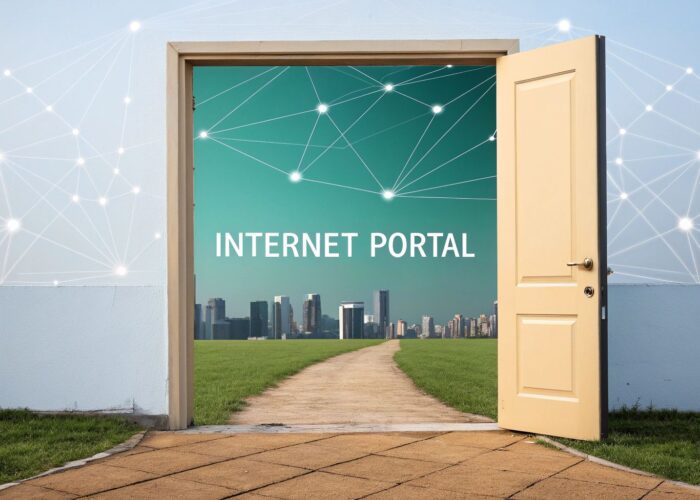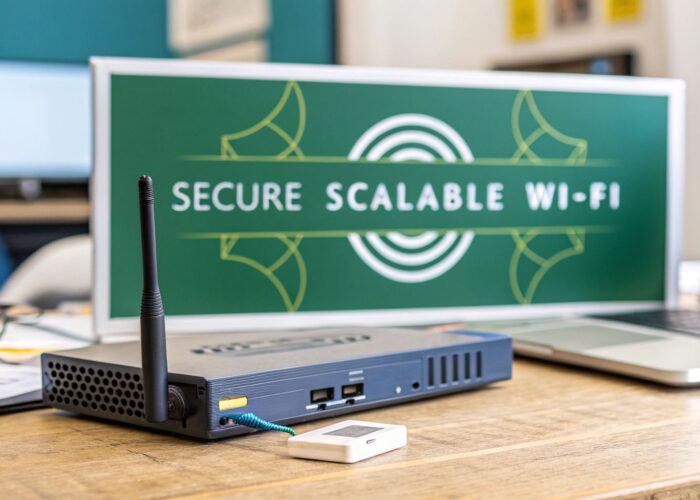Ever connected to the Wi-Fi at a coffee shop or airport and, instead of getting straight to your browser, you landed on a special login page? Hey, we've all been there! That little welcome screen is a captive portal login. Think of it as the friendly digital doorman for countless wireless networks. It's the first thing you see, a welcome page that needs a quick interaction before you're given the keys to the internet.
Understanding the Captive Portal Welcome Page
I like to think of a captive portal as a temporary "walled garden." The moment you connect, the network hardware—like an access point from a company such as Cisco Meraki—catches your first attempt to go online. Before it lets you get to Google or your email, it redirects your browser to its own special web page. That page is the captive portal.
This brief interruption is actually incredibly important. It creates a space where the network owner can ask you to do something—like agree to terms or enter a password—before you get full access. It’s a simple, effective way to manage how guests and users get online.
A captive portal is much more than just a login screen. It's the first handshake between a user and a network, establishing the ground rules for a secure and controlled connection.
What Does a Captive Portal Actually Do?
That login page is a surprisingly versatile tool, and you’ll find it everywhere from schools and shops to corporate offices with BYOD (Bring Your Own Device) policies. Its main jobs are pretty straightforward:
- Authentication: This is all about verifying who you are. It can be as simple as clicking an "I Agree" button, logging in with a social media account, or using more robust security methods like IPSK or EasyPSK.
- Presenting Terms: It's the perfect place to require users to read and accept an acceptable use policy before they connect to the network.
- Branding and Communication: This is where businesses can shine. The page can display a company logo, a welcome message, or even special promotions and ads.
At its core, the captive portal turns an anonymous Wi-Fi connection into a recognized, authorized session.
How Your Connection Is Securely Guided Online
Ever wonder what's happening behind the scenes when you log into a public Wi-Fi network? Let's pull back the curtain. Think of it like checking into a hotel; you can't just walk straight to your room. You have to stop at the front desk first. A captive portal is the digital equivalent of that front desk for a Wi-Fi network.
The second your device connects to the guest Wi-Fi, the network hardware—say, a Cisco access point—steps in. It catches your very first attempt to browse the web. Instead of taking you to Google, your browser is rerouted to a specific web page. That page is the captive portal.
This initial redirect is a fundamental security step, making sure no one gets online without first checking in.
The entire process is designed to identify and authorize every single device before it's granted full access to the internet.
The Authentication Handshake
Once you land on that portal page, you’re in a walled garden. The network now asks you to "authenticate" yourself. This could be as simple as ticking a box to accept the terms of service, or it might require a password or even a social media login.
In environments like Education, Retail, or corporations with a BYOD policy, you’ll see more advanced Authentication Solutions. These places often use powerful hardware from vendors like Meraki to handle thousands of connections at once, and the portal is just the starting point for much tighter security.
A captive portal acts as a digital gatekeeper. It holds all traffic until the user provides the correct credentials, ensuring no unverified devices can access the broader network.
For example, a shared Wi-Fi password in an office with a BYOD (Bring Your Own Device) policy is a huge security hole. To solve this, solutions like IPSK and EasyPSK can be built right into the captive portal login. This way, the system can give each user or device its own unique key, which is a massive upgrade for network security.
After you've done what the portal asks, it sends a green light to the network controller. Your device's status is flipped from "unauthorized" to "authorized," the firewall opens up, and you're free to browse the internet. Your digital check-in is complete.
Why Businesses Really Use Captive Portals
A captive portal is so much more than just a login page. For any smart organization, it's a powerful tool for security, marketing, and keeping the network running smoothly. It's no wonder businesses everywhere—from local coffee shops and university campuses to sprawling corporate offices—have made them a standard part of their setup. They solve a ton of problems all at once, giving users the Wi-Fi they want while giving the business the control it needs.
The market numbers really tell the story here. The global demand for secure, managed internet access has pushed the captive portal market to an estimated USD 1.06 billion in 2024. And it’s not slowing down, with projections hitting USD 3.50 billion by 2033. This isn't just a niche tech product anymore; it's becoming essential. Discover more insights about the captive portal market on straitsresearch.com.
Security and Control in a BYOD World
Let's face it, we live in a Bring Your Own Device (BYOD) world. Everyone connects their personal phones, tablets, and laptops to whatever network is available. For a business, that's a huge security headache. A captive portal acts as the gatekeeper, your first line of defense that stops unauthorized devices dead in their tracks. It's an absolutely critical control point, especially when you pair it with solid hardware from companies like Cisco or Meraki.
But it goes beyond just blocking random people. A good portal gives you sophisticated Authentication Solutions that are way better than a simple password scrawled on a whiteboard.
- Unique Credentials: Think of a university where every student has their own login to access the Education network.
- Voucher Codes: Perfect for hotels or conference centers where you want to offer guests timed access.
- Identity Pre-Shared Keys (IPSK): This is a game-changer. It gives every single device its own unique password, a feature that platforms like EasyPSK make simple to manage.
For the IT admins out there, a captive portal is their best friend. It gives them the visibility and control they need to enforce usage policies, manage how much bandwidth people are using, and make sure the network stays compliant.
A Powerful Marketing and Engagement Tool
Here's where it gets really interesting. That login page is prime digital real estate. For a Retail store, it’s a perfect opportunity to show off a new promotion, announce a flash sale, or ask customers to join an email list. Suddenly, offering free Wi-Fi isn't just a cost—it's a direct line to your customers.
When you know how to configure this gateway correctly, you can turn a basic amenity into a real strategic advantage. We actually have a great resource on this, so check out our guide on how to set up guest WiFi to learn the ropes.
Captive Portals You Use Every Day
Ever connected to the Wi-Fi at a hotel, airport, or coffee shop? If you had to first visit a special login page before you could browse the web, then you've used a captive portal. You probably run into them far more often than you think. They're the invisible gatekeepers of public Wi-Fi in all sorts of places, and each business uses them to solve a unique problem.
Managing Access in Schools and Universities
Think about a sprawling university campus. Thousands of students, faculty, and guests are all trying to get online with their own devices—a classic BYOD (Bring Your Own Device) scenario. A single, shared Wi-Fi password would be a security disaster.
This is where captive portals, often powered by reliable hardware from brands like Cisco or Meraki, become essential. They require everyone to log in with their official school ID and password, ensuring only authorized people can access the network.
From Retail Marketing to Corporate Security
In the retail world, free Wi-Fi isn't just a courtesy; it's a powerful marketing tool. When a store asks for your email address in exchange for internet access, that's a captive portal at work. It turns a simple amenity into a way for them to send you special offers and build a relationship.
For corporate offices, security is everything. A captive portal creates a separate, secure network just for guests. This keeps visitors online and productive without giving them a backdoor into sensitive company files. Advanced Authentication Solutions like IPSK or EasyPSK can even generate unique, temporary passwords for each visitor that expire automatically.
You can learn more about how a well-designed WiFi captive portal can secure and enhance your own network.
Captive portals are key compliance tools in our data-conscious world. Their ability to manage user consent is a major reason why the market was valued at USD 1.94 billion in 2024, with projections to hit USD 6.20 billion by 2033.
That massive growth is fueled by data privacy laws like GDPR. These regulations require businesses to get clear consent before collecting user data—a job tailor-made for a captive portal's welcome screen. For more details on this trend, you can find a comprehensive market analysis at marketsandmarkets.com.
How Different Industries Use Captive Portals
To see just how versatile this technology is, here's a quick look at how various sectors put captive portals to work to meet their specific goals.
| Sector | Primary Goal | Common Authentication Method |
|---|---|---|
| Retail & Hospitality | Marketing & Customer Engagement | Social Media Login, Email Capture |
| Education | Network Security & Access Control | Student/Staff ID & Password (802.1X) |
| Healthcare | Secure Guest Access & Compliance | Self-Registration, SMS Verification |
| Corporate Offices | Visitor Management & Security | Pre-Generated Vouchers, Sponsor Approval |
| Public Venues | Bandwidth Management & Data Analytics | Tiered Access (Free/Paid), Social Login |
From a simple email signup at a cafe to a sophisticated, secure login at a corporate headquarters, captive portals are the flexible solution that makes public Wi-Fi work safely and effectively.
Moving Past the Basic Wi-Fi Password
We've all been there—asking for the Wi-Fi password at a coffee shop or office and getting a sticky note with a generic phrase on it. While simple, handing out that same password to everyone is a massive security headache, especially for busy places like corporate offices or schools.
A shared password is a single point of failure. If just one person leaks it, your entire network is suddenly wide open. This is why modern networks, especially those built on powerful hardware from companies like Cisco and Meraki, need a much smarter way to manage access. The goal is simple: make it secure without making it complicated. This is where the captive portal login comes in.
Giving Everyone Their Own Key
Instead of one master key for everyone, what if you could give each user and every device its own unique, private key to the Wi-Fi? That's the powerful idea behind Identity Pre-Shared Keys (IPSK). Solutions like EasyPSK make this incredibly straightforward. You're no longer dealing with a chaotic free-for-all; each connection is now tied to a specific, identifiable user or device.
This completely changes the security game in a few key areas:
- Education: Imagine securely connecting thousands of student devices in a BYOD (Bring Your Own Device) setting without overwhelming your IT team.
- Corporate: You can grant temporary, unique access to guests and contractors without ever giving them access to your internal network.
- Retail: Keep your staff devices on a secure, private network while your public guest Wi-Fi remains completely separate and managed.
This method does away with the security nightmare of shared passwords. A well-designed captive portal for WiFi acts as the perfect front door for these more advanced security systems, making the whole process seamless for the user.
The explosive growth in this area tells the whole story. The global captive portal market was valued at USD 1.17 billion in 2025 and is expected to hit USD 1.89 billion by 2029. As you can discover more insights about captive portal market growth on researchandmarkets.com, it's clear that managed, secure access isn't just a trend—it's becoming essential.
Creating a Smarter Login Experience
A basic captive portal gets the job done, but a customized one can do so much more for both your visitors and your organization. Think of it this way: solutions like Splash Access can take the standard login on your Cisco Meraki hardware and turn it into a branded, welcoming front door.
It all starts with a beautifully designed, mobile-friendly landing page that mirrors your brand's unique identity.
But it’s not just about looks. The real power comes from offering flexible Authentication Solutions that make sense for your specific environment. In Education, Retail, or a corporate BYOD setting, one size rarely fits all.
You need options. This could mean letting guests sign in with a quick social media click, issuing secure vouchers for temporary access, or deploying advanced systems like IPSK. With features like EasyPSK, for example, you can assign every single user their own unique Wi-Fi password—a massive boost for network security.
The goal is to elevate the captive portal login from a simple gatekeeper to an intelligent touchpoint. It should provide a seamless journey for users while giving administrators valuable analytics and control.
When you get this right, you're doing more than just handing out internet access. You're building a smarter, more secure connection for everyone involved. To see how different platforms compare, check out our guide on the 12 best captive portal solutions on the market today.
Common Questions About Captive Portal Logins
Even after you get the hang of what a captive portal login is, a few nagging questions always seem to surface. Let's clear up these common hurdles so you can handle guest Wi-Fi like a pro.
Why Isn't the Login Page Showing Up?
This is the big one, right? You're connected to the Wi-Fi, but that crucial login page is nowhere to be found.
Nine times out of ten, the simplest fix works. Just open your web browser and try to navigate to a non-secure site, like an old-school news site that uses HTTP instead of HTTPS. This simple action often triggers the network to redirect you to the portal page. If that little trick doesn't do it, head to your device's Wi-Fi settings, tell it to "forget" the network, and then try connecting again from scratch.
Is Captive Portal Wi-Fi Safe?
It's a mixed bag. The portal adds a layer of security for the network provider by controlling who gets on, but it doesn't automatically make your connection private.
Always, and I mean always, look for that little padlock icon (HTTPS) in your browser's address bar before you type in any passwords or personal details. That lock is your signal that the connection between your device and that specific website is encrypted.
Remember, captive portals on robust systems like Cisco Meraki are all about managing access to the network. The safety of your browsing data still comes down to you making sure you're on secure, encrypted websites.
If you want to get into the nitty-gritty of how these systems operate, check out our network manager's guide to captive portals for a deeper look at security protocols and best practices.
Ready to transform your guest Wi-Fi? Splash Access provides powerful, customizable captive portal solutions for Cisco Meraki hardware, complete with advanced authentication and deep analytics. Visit us at https://www.splashaccess.com to learn more.






